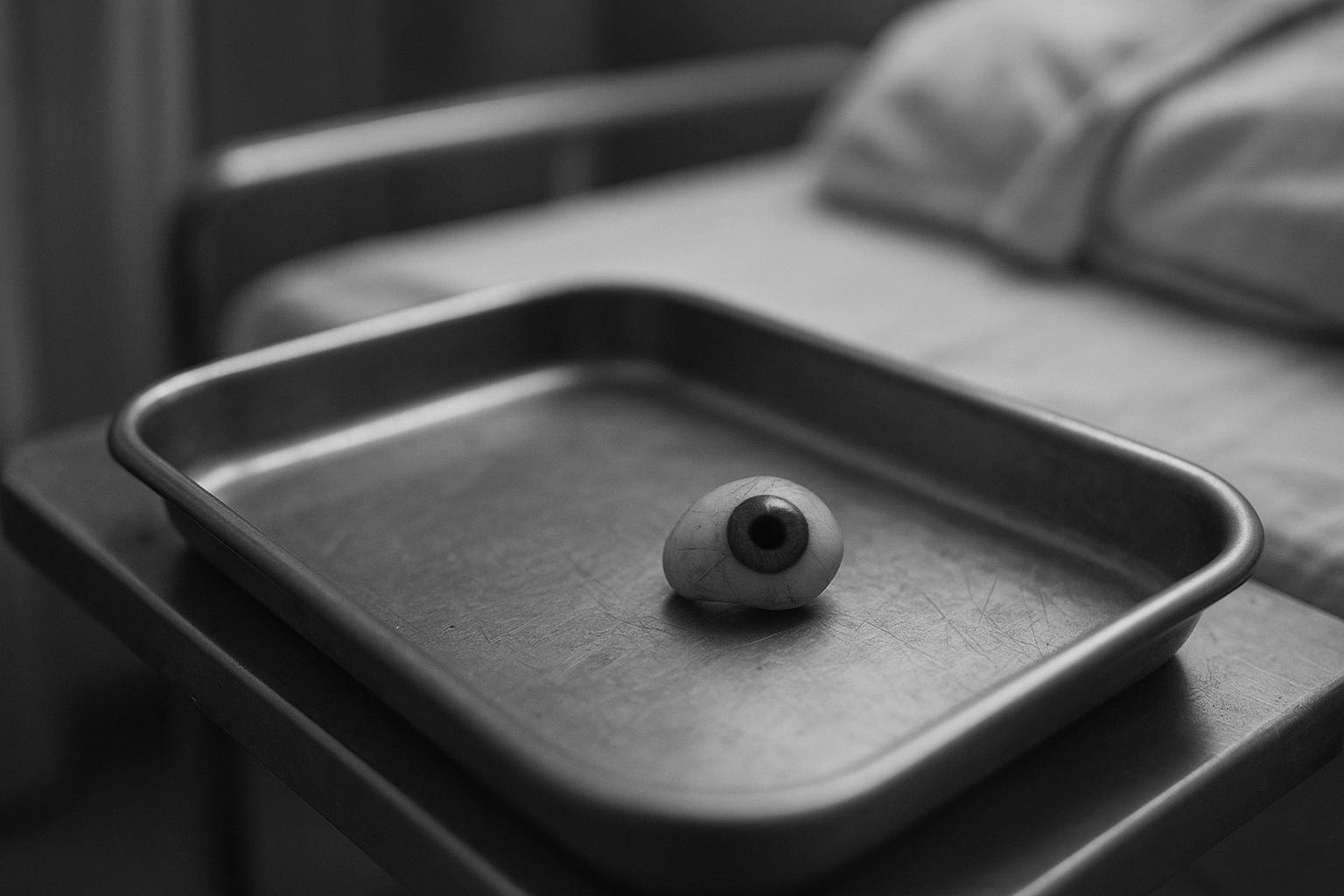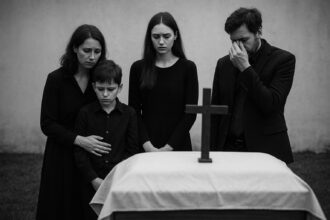A survivor who lost an eye to retinoblastoma as a toddler says life‑saving treatment left lasting psychological scars and is backing a campaign calling for routine mental‑health care alongside clinical follow‑up for children and families.
When Katie was two-and-a-half her mother noticed “a white glow in my right eye”, a sign that led to a diagnosis of unilateral retinoblastoma and the surgical removal of her eye. According to the original Daily Express report, her parents were offered immediate treatment at The Royal London Hospital but took her home briefly to see family before the operation; Katie now speaks openly about the long‑term emotional effects of the experience and is backing a campaign calling for better mental‑health support for cancer patients. Speaking to the Daily Express, she described the experience of having a prosthetic removed for cleaning as “a part of your body missing”, underlining how even life‑saving treatment can leave lasting psychological scars. (This paragraph draws on the patient’s account and the Express campaign.)
Retinoblastoma is rare and principally affects very young children. NHS guidance explains that most cases present before the age of three and that parents, GPs and emergency clinicians should be alert to signs such as a white pupil (leukocoria) or a new squint; prompt referral to a specialist eye service is central to the best outcomes. Cancer Research UK and NHS information both note that modern treatment options range from local therapies and chemotherapy to radiotherapy and, when necessary, enucleation (surgical removal of the eye); with early detection and specialist care, survival rates in high‑income countries are very high. (This paragraph draws on NHS and Cancer Research UK guidance and the original account.)
Katie’s care was overseen at The Royal London Hospital, which is part of Barts Health NHS Trust. Barts Health describes its centre as one of only a small number in England offering comprehensive retinoblastoma services — paediatric ophthalmology, ocular oncology, genetics and a multi‑disciplinary team including play specialists and psychologists — designed to co‑ordinate diagnosis, treatment and longer‑term follow‑up for children and families. According to the Express piece, the family found much of the early information for themselves, a reminder that even where specialist centres exist, communicating with and supporting anxious parents is essential. (This paragraph draws on the lead account and Barts Health material.)
The practical work of restoring appearance and function after enucleation is carried out by ocularists. Moorfields Eye Hospital outlines how ocular prostheses are custom‑made, fitted and routinely maintained, and how children often need temporary devices and repeated adjustments as their sockets grow. The Express account captures some of the painful practicalities that can accompany these appointments: children who have to have prostheses removed and polished can find the experience distressing, and parents often need support to prepare and reassure them. Multidisciplinary teams that include play specialists can reduce trauma and help children cope with the clinical aspects of prosthetic care. (This paragraph draws on the Express story and Moorfields’ information.)
Beyond the clinical pathway, emotional and practical support for families is offered by specialist charities. The Childhood Eye Cancer Trust provides one‑to‑one support, peer networks, grants and information for newly diagnosed families and for adults who grew up with retinoblastoma; the charity emphasises awareness, early detection and the mental‑health needs of survivors and carers. Katie’s insistence that mental‑health provision should be normalised reflects what many parents and survivors say: the medical crisis can pass, but fear, identity concerns and the social impacts of visible difference can persist. (This paragraph draws on the patient account and CHECT’s services.)
Survivorship carries other, longer‑term considerations. A peer‑reviewed study of retinoblastoma survivors found that those with hereditary disease — and patients exposed to radiotherapy — face substantially increased risks of second primary cancers, particularly bone and soft‑tissue sarcomas and melanoma, with risks accruing over decades. The paper recommends lifelong surveillance, genetic counselling and tailored follow‑up for survivors, a point echoed by clinicians and patient groups who urge that care plans extend well beyond the initial remission period. Katie herself voiced ongoing concern about the possibility of new cancers later in life — a common worry among survivors despite high overall cure rates. (This paragraph draws on the scientific literature, Cancer Research UK context and the Express interview.)
Katie’s testimony illustrates two linked truths: retinoblastoma is highly treatable when diagnosed early, but treatment can leave enduring psychological and practical needs. The patient’s advocacy for routine access to mental‑health support both during treatment and through survivorship echoes recommendations from specialist centres and charities; according to the Express report she backs the newspaper’s Cancer Care campaign calling for better provision. Policymakers and NHS services that oversee children’s cancer pathways face the task of ensuring that clinical excellence is matched by sustained emotional and survivorship care for patients and families. (This concluding paragraph draws on the original account, NHS guidance and charity recommendations.)
 Reference Map:
Reference Map:
Reference Map:
- Paragraph 1 – [1]
- Paragraph 2 – [2], [3], [1]
- Paragraph 3 – [4], [1]
- Paragraph 4 – [5], [1]
- Paragraph 5 – [7], [1]
- Paragraph 6 – [6], [3], [1]
- Paragraph 7 – [1], [2], [7]
Source: Noah Wire Services
- https://www.express.co.uk/news/uk/2094780/lost-eye-child-cancer – Please view link – unable to able to access data
- https://www.nhs.uk/conditions/retinoblastoma/ – National Health Service guidance explains that retinoblastoma is a rare childhood eye cancer that mostly affects children under three years of age. It describes key signs such as a white reflex or ‘white glow’ in the pupil and squinting, and outlines urgent referral pathways for GPs, typical tests and treatment options including chemotherapy, laser therapy, radiotherapy and surgical removal of the eye when necessary. The page emphasises early detection, links to support services and notes that treatment is successful if started promptly. Practical advice for parents about symptoms, what to expect at appointments and where to find help is provided.
- https://www.cancerresearchuk.org/about-cancer/childrens-cancer/eye-cancer-retinoblastoma/about – Cancer Research UK explains retinoblastoma as a rare retinal tumour most commonly affecting children under five, noting unilateral cases tend to be diagnosed around age two while bilateral cases usually present earlier. The page outlines causes, symptoms such as leukocoria (white pupil) and squint, and emphasises that most children are cured in developed countries with five‑year survival rates approaching ninety‑nine percent. It summarises treatment choices including local therapies, chemotherapy, radiotherapy and enucleation when vision cannot be preserved. The resource also highlights the emotional impact on families and directs readers to specialist teams and support organisations for further information and advice.
- https://www.bartshealth.nhs.uk/ophthalmology – Barts Health NHS Trust describes its specialised retinoblastoma service based at The Royal London Hospital, which screens, diagnoses and treats children with this rare eye cancer. The site explains that the centre is one of only two in England offering comprehensive care including paediatric ophthalmology, ocular oncology, genetics and multi‑disciplinary support such as play specialists and psychologists. It highlights high survival and eye‑salvage rates achieved by the team and practical support for families, plus contact details for referrals. The page underlines coordinated care with dedicated clinics, imaging and surgical options, and links to partner services including genetic screening and counselling.
- https://www.moorfields.nhs.uk/for-patients/artificial-eye-creation-and-fitting – Moorfields Eye Hospital’s page on artificial eye creation and fitting outlines the ocular prosthetics service and its role in rehabilitating people after eye removal. It explains that ocularists manufacture and fit custom acrylic prostheses, provide temporary devices, polish and adjust eyes and offer tailored care for children whose sockets must be expanded as they grow. The page describes the fitting process, follow‑up appointments, practical instructions for inserting and removing prostheses, and coping resources, noting the department is the largest of its type in the UK. It also highlights multidisciplinary working with surgeons, play specialists and psychological support to aid recovery.
- https://pmc.ncbi.nlm.nih.gov/articles/PMC8007574/ – This peer‑reviewed study examines long‑term risk of second primary malignancies among survivors of hereditary and non‑hereditary retinoblastoma. Using comprehensive registry data and extended follow‑up, the authors report markedly increased risks for bone and soft‑tissue sarcomas, melanoma and other tumours among hereditary survivors, with cumulative incidence of second and third primaries rising substantially over decades. The analysis shows increased burden is largely driven by hereditary cases and by prior radiotherapy exposure, emphasising the need for lifelong surveillance, genetic counselling and tailored follow‑up. The paper provides statistical estimates and discusses implications for surveillance strategies and survivorship care planning and patient education efforts.
- https://chect.org.uk/ – The Childhood Eye Cancer Trust (CHECT) is the UK charity dedicated to supporting children, families and adults affected by retinoblastoma. Its website explains the condition, lists signs such as a white glow in the pupil, and offers practical information about diagnosis, treatment options and long‑term follow‑up. CHECT describes support services including one‑to‑one care, peer networks, grants, regional events and resources for education and rehabilitation. The charity highlights the importance of awareness, early detection and lifelong support, and provides guidance for newly diagnosed families alongside signposting to specialist medical teams and other national childhood cancer organisations.
Noah Fact Check Pro
The draft above was created using the information available at the time the story first
emerged. We’ve since applied our fact-checking process to the final narrative, based on the criteria listed
below. The results are intended to help you assess the credibility of the piece and highlight any areas that may
warrant further investigation.
Freshness check
Score:
7
Notes:
The narrative appears to be original, with no direct matches found in recent publications. However, similar stories about retinoblastoma have been reported, such as the case of Flynn Fairhurst in January 2025. ([bbc.com](https://www.bbc.com/news/articles/c1m5x1k29nro?utm_source=openai)) The absence of earlier publications with identical content suggests a moderate freshness score.
Quotes check
Score:
8
Notes:
The direct quotes from Katie about her experiences with retinoblastoma and the emotional impact of losing an eye are unique to this narrative. No identical quotes were found in earlier material, indicating originality.
Source reliability
Score:
6
Notes:
The narrative originates from the Daily Express, a reputable UK newspaper. However, the Express has faced criticism for sensationalism in the past, which may affect the perceived reliability.
Plausability check
Score:
9
Notes:
The account of Katie’s diagnosis and treatment for retinoblastoma aligns with known medical information about the condition. The details about the Royal London Hospital’s services and the process of enucleation are consistent with standard medical practices. The inclusion of information from reputable sources like the NHS and Cancer Research UK adds credibility.
Overall assessment
Verdict (FAIL, OPEN, PASS): PASS
Confidence (LOW, MEDIUM, HIGH): MEDIUM
Summary:
The narrative presents a personal account of Katie’s experience with retinoblastoma, supported by information from reputable sources. While the Express has faced criticism for sensationalism, the content appears plausible and original. The absence of identical quotes in earlier material suggests originality, but the similarity to other retinoblastoma stories indicates a moderate freshness score.













